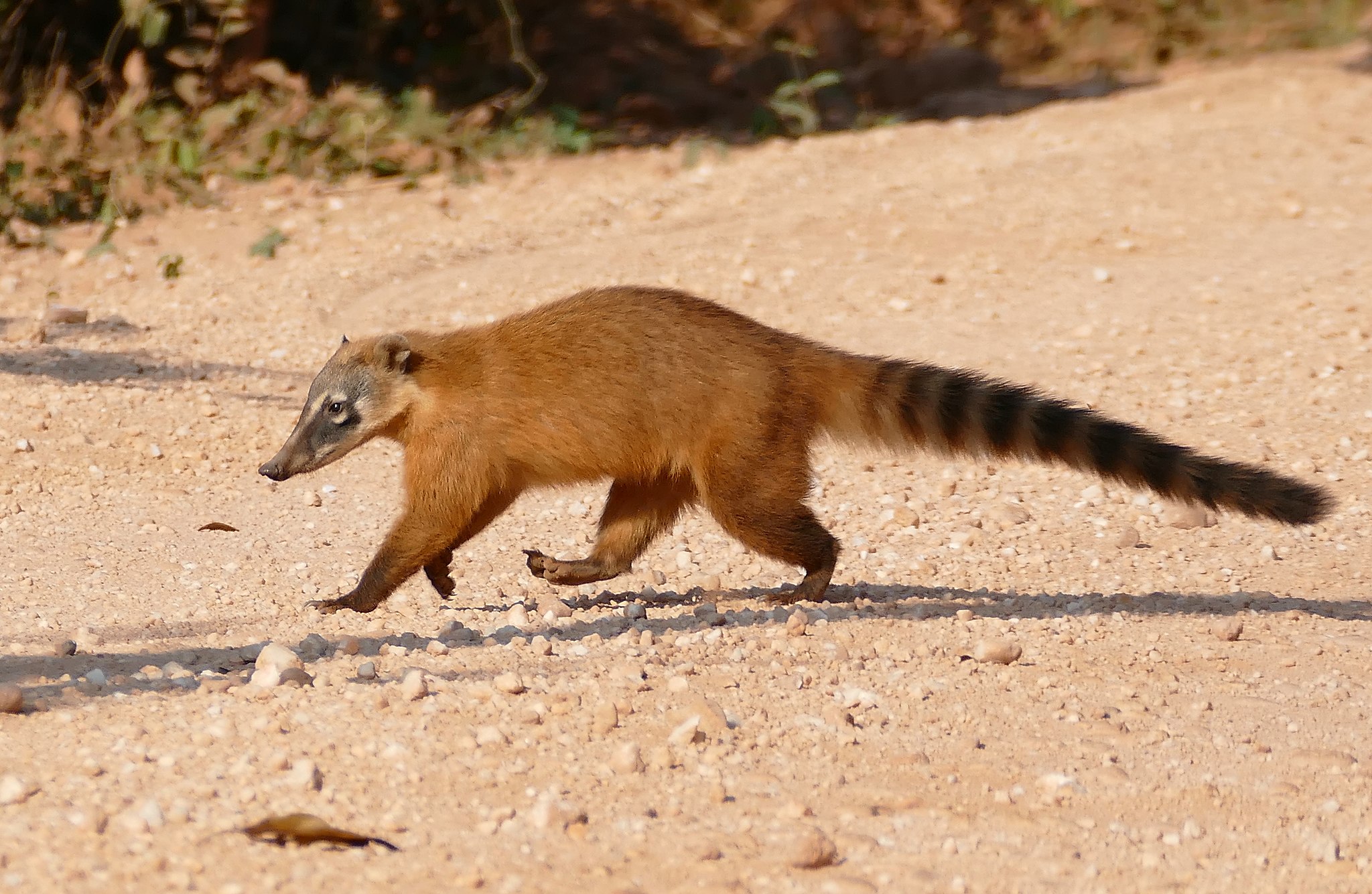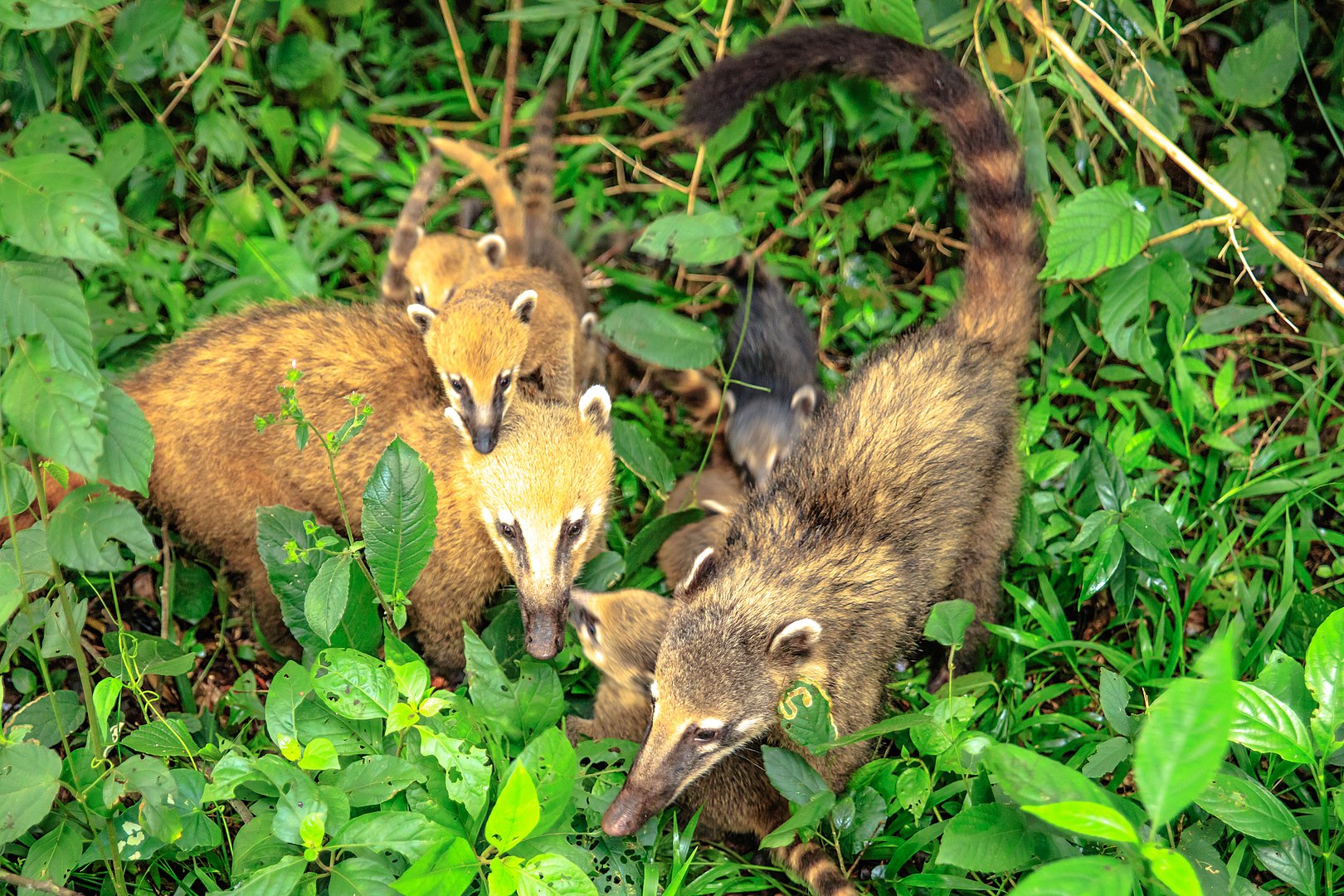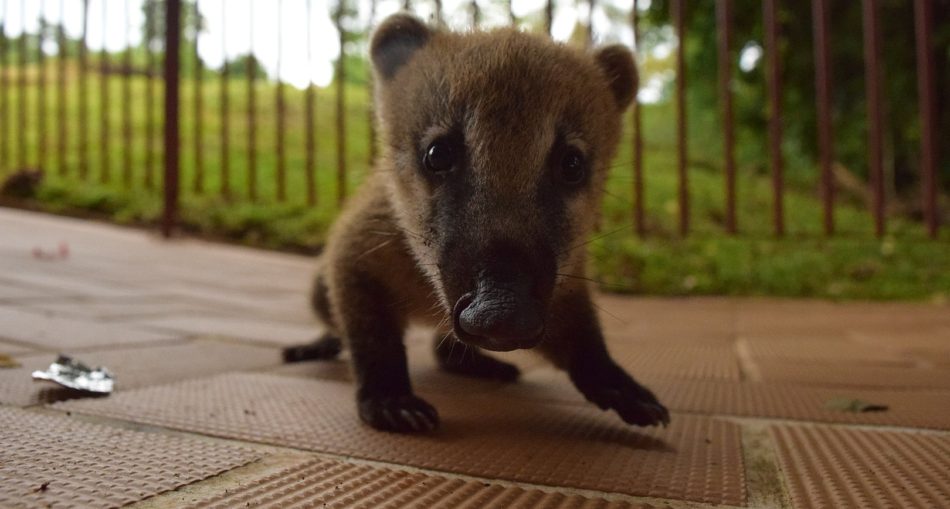Coati is also known as coatimundi which is said to be derived from the Tupian languages of Brazil. The coati is a member of the family (Procyonidae) in the genera Nasua and Nasuella. They are diurnal mammals native to South America, Central America, Mexico, and the southwestern United States. Coatis can be fierce fighters especially when they are provoked or defending themselves. Their strong jaws, sharp canine teeth, and fast scratching paws, along with a tough hide sturdily attached to the underlying muscles, make it very difficult for potential predators (e.g., dogs or jaguars) to seize them. The species of coati found in Guyana is called the South American coati (Can-Coon) or the ring-tailed coati. This is a member of the raccoon family from tropical and subtropical South America (Guyana).
Coati is also known as coatimundi which is said to be derived from the Tupian languages of Brazil. The coati is a member of the family (Procyonidae) in the genera Nasua and Nasuella. They are diurnal mammals native to South America, Central America, Mexico, and the southwestern United States. Coatis can be fierce fighters especially when they are provoked or defending themselves. Their strong jaws, sharp canine teeth, and fast scratching paws, along with a tough hide sturdily attached to the underlying muscles, making it very difficult for potential predators (e.g., dogs or jaguars) to seize them. The species of coati found in Guyana is called the South American coati (Can-Coon) or the ring-tailed coati. This is a member of the raccoon family from tropical and subtropical South America (Guyana).
Tip: The South American Coati’s color is highly variable and the rings on the tail may be only somewhat visible, but its distinguishing characteristic is that it lacks the largely white snout (or “nose”) of its northern relative, the white-nosed coati.
Features Of The Coati

By Bernard DUPONT from FRANCE – South American Coati (Nasua nasua) female crossing the road …, CC BY-SA 2.0, https://commons.wikimedia.org/w/index.php?curid=50429052
- Overall Body – All coatis share a slender head with an elongated, flexible, slightly upward-turned nose, small ears, dark feet, and a long, non-prehensile tail used for balance and signaling.
- Color – Ring-tailed coatis have either a light brown or black coat, with a lighter under-part and a white-ringed tail in most cases. Coatis have a long brown tail with rings on it which are anywhere from starkly defined like a raccoon’s to very faint. Like raccoons and unlike ring-tailed cats and cacomistles, the rings go completely around the tail.
- Paws – Coatis have bear-and raccoon-like paws, and walk plantigrade (on the soles of the feet, as do humans), like raccoons and bears. Coatis have nonretractable claws.
- Snout – The coati snout is long and somewhat pig-like– part of the reason for its nickname ‘the hog-nosed raccoon’.
- Limbs – Coatis have strong limbs to climb and dig and have a reputation for intelligence, like their fellow procyonid, the raccoon.
- Weight & Length – An adult generally weighs 2–7.2 kg (4.4–15.9 lb) and is 85–113 cm (33–44 in) long, with half of that being its tail.
Scientific Classification Of The Coati
Coati – Nasua nasua [Scientific name]
- Kingdom: Animalia
- Phylum: Chordata
- Class: Mammalia
- Order: Carnivora
- Family: Procyonidae
- Genus: Nasua
- Species: N. nasua
Did You Know? In Brazilian Portuguese, the coati is known as quati.
Habitat Of The Coati
The South American coati is widespread in tropical and subtropical South America. It occurs in the lowland forests east of the Andes as high as 2,500 m (8,200 ft) from Colombia and The Guianas south to Uruguay and northern Argentina. It has been recorded in west Ecuador, and north and west Colombia. In Argentina, it has been recorded in Santa Fe and Salta Provinces.
Overall, coatis are widespread, occupying habitats ranging from hot and arid areas to humid Amazonian rainforests or even cold Andean mountain slopes, including grasslands and bushy areas.
Diet Of The Coati
Coatis are omnivorous, but primarily eat fruit, invertebrates, other small animals and bird eggs. They search for fruit in trees high in the canopy and use their snouts to poke through crevices to find animal prey on the ground. They also search for animal prey by turning over rocks on the ground or ripping open logs with their claws.
Reproduction Of The Coati
Females typically live in large groups, called bands, consisting of 15 to 30 animals. Males are usually solitary. Solitary males were originally considered a separate species due to the different social habits and were called “coatimundis”, a term still sometimes used today. Neither bands of females nor solitary males defend a unique territory, and territories therefore overlap.
All females in a group come into heat simultaneously when fruits are in season and mate with several males. The gestation period is 74 to 77 days. Captive females give birth to 1–7 young at a time. In the wild, they leave the group for giving birth in a nest built in trees and rejoin the group with their offspring 5–6 weeks later. They usually remain with their natal group. Males generally disperse from their natal group at the age of three years. South American coatis generally live for up to 7 years in the wild but can live up to 14 years in captivity.

A coati family: By Murray Foubister – https://www.flickr.com/photos/mfoubister/24214892214/, CC BY-SA 2.0, https://commons.wikimedia.org/w/index.php?curid=51823517
Five Facts About The Coati
- Coatis often hold their tail erect; it is used as such to keep troops of coatis together in tall vegetation. The tip of the tail can be moved slightly on its own, as is the case with cats, but it is not prehensile as is that of the kinkajou, another procyonid.
- Coatis also are, in common with raccoons and other procyonids (and others in the order Carnivora and rare cases amongst other mammals), double-jointed and their ankles can rotate beyond 180°; they are therefore able to descend trees headfirst.
- Their snout is extremely flexible – it can be rotated up to 60° in any direction. They use their noses to push objects and rub parts of their body.
- They prefer to sleep or rest in elevated places and niches, like the rainforest canopy, in crudely built sleeping nests. Coatis are active day and night.
- Group members produce soft whining sounds, but alarm calls are different, consisting of loud woofs and clicks. When an alarm call is sounded, they climb trees, and then drop down to the ground and disperse. Predators of the South American coati include foxes, jaguars, jaguarundis, domestic dogs, and people.
Coati in Guyana
At a distance one may see nothing more than several erect, slowly waving tails as a group of coatis forage on the ground. Coati groups usually number up to 60 which consists of females and their young. Male coatis are solitary except during the breeding season. The South American coati climbs well and may feed on fruit in the canopy, or rest on branches during the day and at night, but it also feeds and travels on the ground, digging through the leaf litter and under logs for tubers and invertebrates. Small vertebrates are also taken. When disturbed, one member of the group will bark and the rest of the group will flee, climbing up to a safe vantage. Chitters, squeals and soft calls are also given. Yes, the coati found in Guyana has some amazing abilities and a unique personality.
Article References:
- https://iwokrama.org/mammals/
- https://en.wikipedia.org/wiki/Coati
- https://en.wikipedia.org/wiki/South_American_coati
- Main Image: By Fabiancm – Own work, CC BY-SA 3.0, https://commons.wikimedia.org/w/index.php?curid=40278287








1 Comment